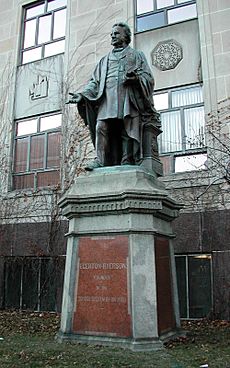Canadian Indian residential school gravesites facts for kids
Throughout its history, between 3,200 and 6,000 students died while attending the Canadian Indian residential school system. The exact number remains unknown due to incomplete records. Comparatively few cemeteries associated with residential schools are explicitly referenced in surviving documents, however the age and duration of the schools suggests that most had a cemetery associated with them. Most cemeteries were unregistered, and as such the locations of many burial sites of residential school children have been lost. The Truth and Reconciliation Commission of Canada has called for "the ongoing identification, documentation, maintenance, commemoration, and protection of residential school cemeteries or other sites at which residential school children were buried."
The Canadian Indian Residential Schools were a network of boarding schools for Indigenous peoples. Directed and funded by the Department of Indian Affairs, and administered mainly by Christian churches, the residential school system removed and isolated Indigenous children from the influence of their own native culture and religion in order to forcefully assimilate them into the dominant Canadian culture. Given that most of them were established by Christian missionaries with the express purpose of converting Indigenous children to Christianity, schools often had nearby mission churches with community cemeteries. Students were often buried in these cemeteries rather than being sent back to their home communities, since the school was expected by the Department of Indian Affairs to keep costs as low as possible. Additionally, occasional outbreaks of disease led to the creation of mass graves when the school had insufficient staff to bury students individually.
Bodies, unmarked graves, and potential burial sites have been identified near residential school sites across Canada since the 1970s, mainly using ground-penetrating radar. To date, the sites of unmarked graves are estimated to hold the remains of more than 1,900 previously unaccounted individuals. However, across the entire residential school system, the number of identifiable children who are documented as having died while in their custody is over 4,100 individuals; the fourth volume of the Truth and Reconciliation Commission of Canada "identified 3,200 deaths on the Truth and Reconciliation Commission's Register of Confirmed Deaths of Named Residential School Students and the Register of Confirmed Deaths of Unnamed Residential School Students". The issue of unmarked graves gained renewed attention after an anthropologist detected ground disturbances on radar at Kamloops Indian Residential School in May 2021, and concluded that these were 215 "probable burials" (this number was later revised to 200). Several similar announcements followed over the ensuing months, leading to commemorations and protests, as well as leading to a series of arsons against Christian buildings and the 2022 "penitential" visit to Canada by Pope Francis.
Reactions
Community memorials have been set up at the Vancouver Art Gallery, the Ontario Legislative Building, as well as various government buildings and church buildings that had been in charge of running the residential school system.
Prime Minister Justin Trudeau asked that flags on all federal buildings be flown at half-mast. On June 2, 2021, the federal government pledged C$27 million in immediate funding to the National Centre for Truth and Reconciliation to identify the unmarked graves. The provincial governments of British Columbia, Alberta, Saskatchewan, Manitoba and Ontario also pledged C$12 million, C$8 million, C$2 million, C$2.5 million and C$10 million, respectively, to fund searches. MPs Mumilaaq Qaqqaq and Charlie Angus have called on Justice Minister David Lametti to launch an independent investigation on crimes against humanity in Canada. Canada Day festivities were cancelled in some communities in British Columbia, Alberta, Northern Saskatchewan and New Brunswick.
The Canadian School Boards Association has asked for the development of a Canada-wide curriculum on Indigenous history, to be taught from kindergarten to Grade 12. In New Brunswick, Education Minister Dominic Cardy said the education curriculum would be amended to teach about the province's Indigenous day schools.
The United Nations Human Rights Office and independent UN human rights experts have called on Canada and the Holy See to investigate the uncoveries. Similar sentiments were echoed by the governments of China, Russia, Belarus, Iran, North Korea, Syria and Venezuela.
The identification of possible gravesites at Kamloops has been followed by calls for name changes and removals of monuments commemorating figures controversial for their colonial views or policies towards Indigenous peoples. These include monuments to Egerton Ryerson, John A. Macdonald, Hector-Louis Langevin, Oscar Blackburn, Vital-Justin Grandin, and James Cook. The doors of St. Paul's Cathedral in Saskatoon were covered in paint on June 24.
Additionally, although Canada has, since before Confederation, been a constitutional monarchy, in which the sovereign does not make policy and must follow the directions given by ministers and parliamentarians, a school named after Prince Charles was renamed, and statues of Queen Victoria and Queen Elizabeth II were toppled by protesters.
A nationwide survey of editors published by the Canadian Press voted the topic "Children who never returned from residential schools" as the Canadian Newsmakers of the Year in 2021.
See also
- Christianity and colonialism
- Genocide recognition politics § Canada
- List of Indian residential schools in Canada
- Snuneymuxw First Nation § Nanaimo Indian Hospital, for the Snuneymuxw First Nation's investigation into unmarked graves around an Indian hospital



